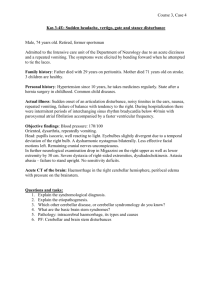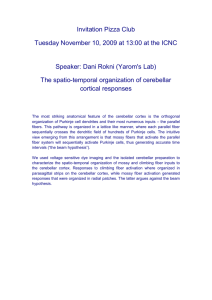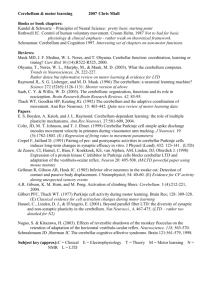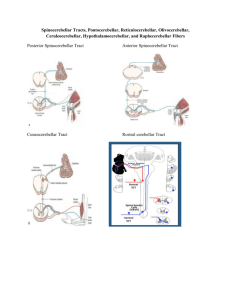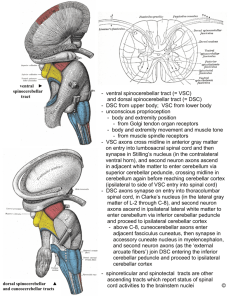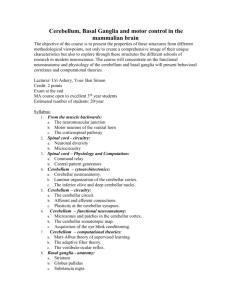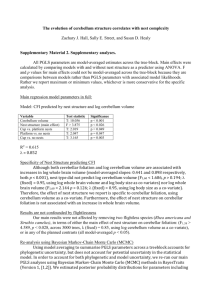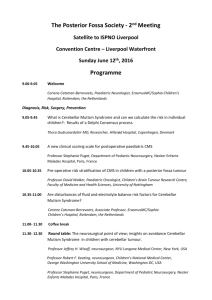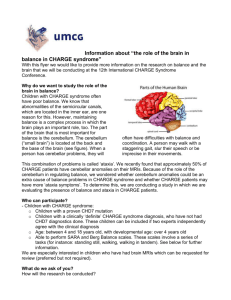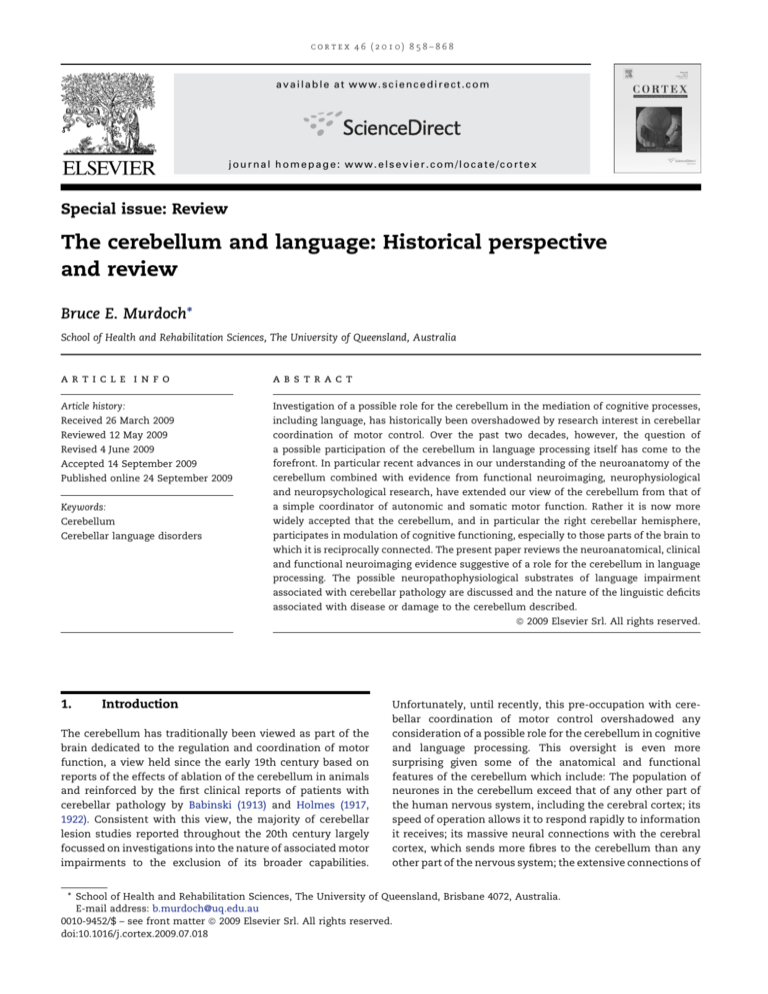
cortex 46 (2010) 858–868
available at www.sciencedirect.com
journal homepage: www.elsevier.com/locate/cortex
Special issue: Review
The cerebellum and language: Historical perspective
and review
Bruce E. Murdoch*
School of Health and Rehabilitation Sciences, The University of Queensland, Australia
article info
abstract
Article history:
Investigation of a possible role for the cerebellum in the mediation of cognitive processes,
Received 26 March 2009
including language, has historically been overshadowed by research interest in cerebellar
Reviewed 12 May 2009
coordination of motor control. Over the past two decades, however, the question of
Revised 4 June 2009
a possible participation of the cerebellum in language processing itself has come to the
Accepted 14 September 2009
forefront. In particular recent advances in our understanding of the neuroanatomy of the
Published online 24 September 2009
cerebellum combined with evidence from functional neuroimaging, neurophysiological
and neuropsychological research, have extended our view of the cerebellum from that of
Keywords:
a simple coordinator of autonomic and somatic motor function. Rather it is now more
Cerebellum
widely accepted that the cerebellum, and in particular the right cerebellar hemisphere,
Cerebellar language disorders
participates in modulation of cognitive functioning, especially to those parts of the brain to
which it is reciprocally connected. The present paper reviews the neuroanatomical, clinical
and functional neuroimaging evidence suggestive of a role for the cerebellum in language
processing. The possible neuropathophysiological substrates of language impairment
associated with cerebellar pathology are discussed and the nature of the linguistic deficits
associated with disease or damage to the cerebellum described.
ª 2009 Elsevier Srl. All rights reserved.
1.
Introduction
The cerebellum has traditionally been viewed as part of the
brain dedicated to the regulation and coordination of motor
function, a view held since the early 19th century based on
reports of the effects of ablation of the cerebellum in animals
and reinforced by the first clinical reports of patients with
cerebellar pathology by Babinski (1913) and Holmes (1917,
1922). Consistent with this view, the majority of cerebellar
lesion studies reported throughout the 20th century largely
focussed on investigations into the nature of associated motor
impairments to the exclusion of its broader capabilities.
Unfortunately, until recently, this pre-occupation with cerebellar coordination of motor control overshadowed any
consideration of a possible role for the cerebellum in cognitive
and language processing. This oversight is even more
surprising given some of the anatomical and functional
features of the cerebellum which include: The population of
neurones in the cerebellum exceed that of any other part of
the human nervous system, including the cerebral cortex; its
speed of operation allows it to respond rapidly to information
it receives; its massive neural connections with the cerebral
cortex, which sends more fibres to the cerebellum than any
other part of the nervous system; the extensive connections of
* School of Health and Rehabilitation Sciences, The University of Queensland, Brisbane 4072, Australia.
E-mail address: b.murdoch@uq.edu.au
0010-9452/$ – see front matter ª 2009 Elsevier Srl. All rights reserved.
doi:10.1016/j.cortex.2009.07.018
cortex 46 (2010) 858–868
its output fibres which pass to many other parts of the nervous
system, including areas of the cerebral cortex well beyond
motor areas.
Since the mid 1980s, however, methodological and
conceptual advances of contemporary neuroscience have
brought about a substantial modification of the traditional
view of the cerebellum as a mere coordinator of autonomic
and somatic motor functions. These advances have included:
Realization of the importance of parallels in the phylogenetic
development of the neocerebellum and association areas of
the cerebral cortex; greater understanding of the neuroanatomy of the cerebellum and its connections with the
cerebral cortex; introduction of advanced neuroimaging
techniques, including functional neuroimaging, capable of
detecting activation of the cerebellum during performance of
language tasks; and advances in neuropsychological/
linguistic testing capable of detection of subtle changes in
cognitive/linguistic function in patients with cerebellar
pathology. Collectively these advances in neuroscience have
established the view that the cerebellum participates in
a much wider range of functions than conventionally
accepted, including cognitive and linguistic functions among
others, in addition to regulation and coordination of motor
function.
Bloedel and Bracha (1997) outlined five periods in the
conceptual growth and development of insights into cerebellar functioning. Firstly, the role of the cerebellum was
considered to be coordination of voluntary movements and
orientation of the body and head in space. Next, an additional
function of the cerebellum was considered to be the regulation and integration of sensory information for reflex organization. Thirdly, the cerebellum was believed to also be
responsible for regulating vestibulo-ocular movements and
posture of the head. Fourthly, the cerebellum was recognized
as an essential structure for learning conditioned responses.
Lastly and most currently, various investigations have indicated a possible role for the cerebellum in the regulation of
linguistic, cognitive, and affective functions.
Currently, it is thought that, in addition to its contribution
to motor control, the cerebellum (particularly the right cerebellum) is responsible for modulating non-motor language
processes and cognitive functions of those parts of the brain to
which it is reciprocally connected (Lalonde and Botez-Marquard, 2000; Silveri and Misciagna, 2000; Marien et al., 2001).
Thus the particular role of the cerebellum in this domain is to
modulate rather than generate language and cognition, the
latter function being considered to be specific to supratentorial structures, particularly the cerebral cortex (Silveri
and Misciagna, 2000). Silveri and Misciagna (2000) described
this role of the cerebellum as representing the interface
between cognition and execution, coordinating information
coming from the supratentorial structures responsible for the
precise cognitive process and its executive level. This
proposed role for the cerebellum in modulating language has
major implications for the assessment and rehabilitation of
patients with cerebellar lesions and challenges conventional
localizationist theories which promote cerebral cortical
exclusivity in relation to language processing in the brain.
Several reasons possibly underly why the recently recognized role for the cerebellum in language and cognition was
859
overlooked for several centuries. According to some authors,
a primary explanation lies in the modulatory role of the
cerebellum in language and cognition, which results in
linguistic and cognitive impairments that are both qualitatively and quantitatively different from those produced by
lesions of supratentorial structures (Silveri and Misciagna,
2000). Akin to models of motor control that define a role for the
cerebellum in the refinement and coordination of movement
(Fabbro, 2000), cerebellar contributions to cognition have been
postulated as high-level in nature (Chafetz et al., 1996; Marien
et al., 2001). In relation to language, it has been proposed that
cerebellar lesions may evoke a form of linguistic incoordination or crudity, potentially manifesting as high-level language
deficits (Cook et al., 2004). Complex or high-level language
measures have been described as tasks that demand frontal
lobe support in the manipulation of novel situations, lexicalsemantic operations, the development of language strategies,
and the organization and monitoring of responses (Copland
et al., 2000). Detection of these high-level linguistic impairments with routine language tests may have been difficult in
previous investigations, as standard language test batteries
may not have been sensitive or extensive enough to identify
such subtle deficits that may follow cerebellar damage (Cook
et al., 2004; Murdoch and Whelan, 2007). Consequently the
presence of subtle, high-level language problems although
present, would most likely have been masked by the severity
of any motor impairment in patients with cerebellar
pathology. Based on the findings of Cook et al. (2004), it would
appear that linguistic disturbances subsequent to cerebellar
lesions may be more accurately detected and characterized by
high-level assessments that evaluate the proficiency of more
complex language processes beyond single word hierarchies.
The aim of the present paper is to review the neuroanatomical, clinical and neuroimaging evidence suggestive of
a role for the cerebellum in language. Further, the possible
neuropathophysiological substrates of language impairment
associated with cerebellar pathology will be explored and the
nature of linguistic deficits caused by disease or destruction of
the cerebellum described.
2.
Evidence from neuroanatomical studies
The primary factor, and hence the cornerstone, in the development of the concept of a cerebellar role in language was the
discovery of major reciprocal neural pathways between the
cerebellum and frontal areas of the language-dominant
hemisphere, including Broca’s area and the supplementary
motor area. In particular the work of Leiner et al. (1986, 1987,
1991, 1993) was fundamental to this development in that they
were the first to draw attention to the possibility that
expanded connections from the cerebellum to the cerebral
cortex and from the cortex to the cerebellum present in
human brains but not in less evolved species, provided
a potential neural substrate for the cerebellum to participate
in cognitive/linguistic functions in addition to motor functions. Specifically, Leiner et al. (1986, 1987, 1989, 1991) drew
attention to long-neglected evidence that the lateral portion of
the cerebellar hemispheres and dentate nuclei (particularly
the ventrolateral phylogenetically newer part referred to as
860
cortex 46 (2010) 858–868
the neodentate) had enlarged significantly greater than any
other part of the brain with the exception of the cerebral
cortex, during the phylogenetic evolution of the human brain.
Importantly this expansion in size had not occurred in parallel
with the cerebral cortex as a whole, but rather specifically in
parallel with the cerebral association areas (Leiner et al., 1986).
In the course of human evolution these expanded parts of the
cerebellum became linked to newly enlarged areas of the
cerebral cortex to form a phylogenetically new cerebro-cerebellar system in humans. Of particular relevance to enabling
the cerebellum to contribute to cognitive/linguistic processes,
these newly formed links between the neocerebellum and the
frontal lobe included not only the frontal motor areas (Brodmann areas 4 and 6) but also other areas of the frontal cortex
including Broca’s area (Brodmann areas 44 and 45) which in
turn send back new connections to the cerebellum. This
reciprocal connectivity forms a series of segregated neural
loops that are hypothesized to facilitate cognitive/linguistic
function in the same way that the cerebellum enhances motor
functions (Leiner et al., 1989).
It has been proposed that the cerebrocortico-cerebellar
loops that connect the lateral parts of the cerebellar hemispheres to the frontal lobe consist of a feedforward, afferent
limb and a feedback efferent limb (Leiner et al., 1986;
Schmahmann, 1996). The feedforward limb is comprised of
two pathways, one of which passes from the cerebral cortex to
the pontine nuclei in the brainstem (cerebrocortico-pontine
pathways) and from there connects via mossy fibre projections to the cortex of the lateral portion of the cerebellar
hemispheres (ponto-cerebellar pathways). The second feedforward limb passes from the cerebral cortex to the red
nucleus, from where the central tegmental tract leads to the
inferior olivary nucleus and then via climbing fibres to the
lateral cerebellar cortex (Schmahmann, 1996). The feedback
limb passes from the dentate nucleus, the primary outflow
nucleus of the cerebellum to the nucleus ventralis
intermedius and nucleus ventralis anterior of the thalamus
via the cerebello-thalamic pathways and from there to various
areas in the contralateral frontal lobe (including Brodmann
areas 6, 44 and 45) via the thalamo-cortical pathways
(Schmahmann, 1996; Engelborghs et al., 1998). Therefore,
although the cerebellum is a relay for many circuits involved
in the control process of several physiological functions (e.g.,
vestibulo-cerebellar-vestibular loops regulate equilibrium and
ocular motility; reticulo-cerebello-reticular loops are involved
in muscle tone, control of posture and regulation of several
vegetative functions; spino-cerebello-rubro-spinal loops
participate in regulation of motor function at the spinal level;
hypothalamo-cerebello-hypothalamic loops regulate visceral
functions) the primary loops involved in the regulation of
voluntary movements and cognitive/linguistic functions are
the cerebrocortico-ponto-cerebellocortico-dentato-thalamocerebrocortical loops (Bloedel and Bracha, 1997; Middleton
and Strick, 1997; Schmahmann and Pandya, 1997) and the
cerebrocortico-rubro-olivo-neodentato-cerebrocortical loops
(Leiner et al., 1991, 1993). Importantly, in both loops each
cerebellar hemisphere sends information to, and receives it
from the contralateral cerebral hemisphere. Therefore the
right cerebellar hemisphere is connected to the left cerebral
hemisphere and conversely. A diagramatic representation of
major cerebrocortico-cerebellar loops in the human brain
proposed by Leiner et al. (1989) is shown in Fig. 1.
Several neuroanatomical studies of the cerebellum have
provided critical evidence that the proposed circuits connecting the cerebellum and non-motor cortical areas do exist.
For example, Middleton and Strick (1994) reported retrograde
transneuronal transport of a retroviral tracer from the
dorsolateral prefrontal cortex to the dentate nucleus. More
recently, the same authors also using a retrograde transneuronal transport technique demonstrated the presence of
cerebello-thalamo-cortical pathways in primates (Middleton
and Strick, 2000).
Fig. 1 – Modified schematic diagram of major cerebro-cerebellar loops in the human brain. Adapted from Leiner et al. (1989).
cortex 46 (2010) 858–868
In summary, anatomically cerebello-cerebrocortical pathways lend themselves to a neuroregulatory role apropos nonmotor and motor functions, via associative as well as motor
cortex terminations. More specifically, the prefrontal, parietal,
temporal, and paralimbic cortices demonstrate topographically organized feedforward projections to the cerebellum
which are siphoned through cortico-pontine and corticorubro-olivary pathways and transmitted via deep cerebellar
nuclei (particularly the dentate nucleus) to thalamic nuclei
and then back to the cerebral cortex (Schmahmann, 1996;
Middleton and Strick, 2000). It has been proposed that this
configuration provides a neural substrate whereby the cerebellum may be actively and directly involved in the organization, construction and execution of higher order
behaviours, including language.
The reciprocal neuroanatomical connections between the
cerebellum and cerebral cortex that are proposed to enable
cerebellar input into cognitive linguistic functions have
a number of parallel features to equivalent pathways involved
in the coordination and modulation of motor function. Indeed,
models of motor control have been lent in the translation of
cerebellar cognitive disturbances. The term ‘‘cerebellar
cognitive affective syndrome’’ was coined by Schmahmann
and Sherman (1998) to describe a syndrome typically characterized by impaired executive function, spatial cognition,
linguistic processing and affective regulation, and has been
operationally defined as ‘‘dysmetria of thought’’ (Schmahmann, 1991, 1996; Gottwald et al., 2003). Analagous to the
overshooting and undershooting of ataxic limb movements,
dysmetria of thought has been hypothesized to involve either
the inadequate or overly elaborate planning or misinterpretation of stimuli. In relation to cognition, the intact cerebellum
has been described as capable of detecting, preventing, and
correcting mismatches between the intended outcomes and
the perceived outcomes of an organism’s interaction with the
environment (Schmahmann, 1998). Therefore, in the same
way as the cerebellum regulates the rate, force, rhythm and
accuracy of movement, it may also control the speed,
capacity, consistency and appropriateness of cognitive and
linguistic processing.
3.
Evidence from clinical studies
Further evidence for a role for the cerebellum in language has
been derived from the evaluation of the performance of
patients with various cerebellar pathologies (including cerebellar atrophy and focal lesions caused by strokes or tumours)
on a range of linguistic and neuropsychological tests. The
results from several clinical studies converge with the
evidence from neuroanatomical and neuroimaging studies to
implicate the cerebellum in various aspects of language function. Fiez et al. (1992) examined a patient with a vascular lesion
of the right cerebellar hemisphere on a word generation task.
Although the patient had high-level conversational skills and
normal performance on standard neuropsychological assessments, he had difficulty storing information and failed in
various semantic word generation tasks. For instance when
asked to generate verbs in response to nouns, he produced
many associated but incorrect errors (e.g., although associated
861
many errors were not verbs such as ‘‘red’’ in response
to ‘‘brick’’) and failed to learn the task normally. Fiez et al.
(1992) theorized that the deficits evident in this case indicated
that the right cerebellar hemisphere was involved in error
detection tasks and control of some semantic and syntactic
aspects of language production. Patients with cerebellar
lesions have also been reported to have difficulty learning new
verbal associations by other researchers. For instance, BrackeTolkmitt et al. (1989) reported that a group of patients with
cerebellar damage were significantly impaired compared to
matched controls at learning random associations between six
words and six colours.
Three aetiologically distinct patient groups with cerebellar
pathology were studied by Leggio et al. (1995) using both
phonological and semantic fluency tests. The phonological
tasks required the subjects to produce as many words as
possible with the initial phonemes F, A, and S within 1 min.
The semantic verbal fluency tasks consisted of the generation
of as many words as possible belonging to the semantic
categories ‘‘birds’’ and ‘‘furniture’’. Two of the groups had
restricted focal lesions (lateral part of the left or right cerebellar hemisphere) while the third group had atrophic lesions
(mainly involving the vermis or paravermal region). Leggio
et al. (1995) reported that as a group the subjects with cerebellar lesions performed at a lower level than matched
controls on both the phonological and semantic fluency tasks.
In addition the atrophic patients obtained better results than
those with focal lesions despite having more severe ataxic
impairments. The patients with atrophic lesions performed
significantly poorer than controls only on the phonological
task and patients with lesions involving the right lateral
cerebellum performed slightly worse than those with focal
lesions to the left cerebellar hemisphere. Overall these findings provided further evidence in support of a functional role
for the cerebellum in language and suggested a strong association, firstly between damage to the lateral cerebellum,
especially the right cerebellar hemisphere and verbal fluency
deficits and secondly between medial cerebellar lesions and
the prevalence of motor deficits. These findings were later
confirmed by Leggio et al. (2000) who also demonstrated that
the observed deficits in verbal fluency were not the outcome of
motor speech impairment. These latter authors also proposed
that cerebellar lesions affect phonological processes to
a greater extent than semantic processes because phonological tasks depend on unusual novel and less automatized
search strategies than semantic tasks.
According to Silveri and Misciagna (2000), patients with
cerebellar damage show differing degrees of impairment in
the various cognitive domains. In fact, different impairments
are recognized at different levels of linguistic organization,
from the articulatory level to sentence production. The cerebellum is active, according to Silveri and Misciagna (2000), in
tasks requiring single word selection and production.
However, as noted in the findings of neuroimaging studies
discussed above (e.g., Silveri et al., 1994), one of the most
interesting findings in patients with cerebellar lesions is
agrammatic speech (a disorder in speech production characterized by simplification of the syntactic structures, reduced
sentence length and omission and substitution of grammatical morphemes) (Silveri and Misciagna, 2000). Several other
862
cortex 46 (2010) 858–868
researchers have also reported agrammatism in association
with right cerebellar lesions (Zettin et al., 1997; Gasparini et al.,
1999; Justus, 2004). Justus (2004) reported that individuals with
cerebellar lesions are less able to discriminate grammatical
and ungrammatical sentences than controls suggesting that
damage to the cerebellum can result in subtle impairments in
the use of grammatical morphology. Occasionally, production
of content words is impaired to different degrees, such that
verbs, for example, may be produced with more difficulty than
nouns (Silveri and Misciagna, 2000).
The language abilities of four patients with focal cerebellar
lesions of differing aetiologies and localized in different areas
of the cerebellum were investigated by Fabbro et al. (2000) to
determine if linguistic difficulties existed and whether these
deficits were stable or evolved following surgery. All four
patients exhibited mild language impairments, particularly
affecting morphosyntactic features and lexical access. The
first patient, who presented with an arachnoid cyst compressing the superior portion of the vermis, exhibited some
morphosyntactic errors in pre-operative spontaneous speech,
while a few months post-surgery no errors were found. While
propositioning had reportedly improved from the pre-surgical
assessment, the most compromised linguistic level was found
to be syntax. Difficulties in some word generation tasks were
also reported, particularly synonym and attribute generation.
The second case presented with a hemangioblastoma compressing the right cerebellar hemisphere. While spontaneous
speech remained fluent, some of the morphosyntactical errors
exhibited pre- and post-surgery resolved ten months
following surgery, as did deficits in syntactic comprehension,
reading and writing. Improvement of propositionizing skills
and morphological and syntactic levels also occurred,
although difficulties in mental arithmetic and synonym
generation did not change. The third patient was diagnosed
with an astrocytoma in the vermis and exhibited cerebellar
dysarthria, nonfluent spontaneous speech, and morphosyntactic errors following surgery. An assessment of language
revealed difficulties in grammatical comprehension, antonyms, morphological opposities, reading and writing, with the
most compromised tasks including propositionizing and
lexical access. Of most significance were impairments in
morphology, syntax, and semantics. Fabbro et al. (2000) suggested that findings from this case particularly supported
involvement of both the right cerebellar hemisphere and the
vermis in language processing. The final patient, with an
astrocytoma involving the left cerebellar hemisphere,
exhibited fluent spontaneous speech with some morphosyntactic errors, poor grammatical comprehension and
arithmetic, significantly poor performance in both propositionizing and reading, and significantly impaired syntax.
While two of the patients (one with an arachnoid cyst compressing the superior portion of the vermis, and the other with
a hemangioblastoma compressing the right cerebellar hemisphere) showed partial recovery of linguistic deficits following
surgery, the remaining two (both with cerebellar tumours) did
not experience an improvement in language function.
In contrast, based on administration of standard aphasia
tests to children and adolescents with acute focal cerebellar
lesions following surgery for the treatment of posterior fossa
tumours, Frank et al. (2008) reported no statistically significant
difference in the language abilities of children with right and
left-sided lesions and controls. These authors did, however,
note the presence of mild signs of language disturbance,
primarily related to reduced performance on written language
tasks, in two subjects with right-sided cerebellar lesions.
Fabbro et al. (2000) believed that the mild linguistic deficits
evidenced by their four cases with focal cerebellar lesions
demonstrated an alteration of language control processes
rather than to a structural impairment of specific components
of the language system. In their view, the vermis and portions
of the cerebellar hemispheres operate within a large functional language network as an organizational control mechanism via the frontal lobe system. The rapid recovery of
linguistic disturbances noted in two of the four patients
following acute cerebellar damage was attributed to partial
functional reactivation of linguistic centres after regression of
diaschisis phenomena. The recognition that linguistic deficits
may be compensated for over time prompted Frank et al.
(2007) to examine language function in children and adolescents in the acute stage (a few days) after surgically induced
cerebellar lesions when maximal disruption of language
function could be expected. Although their findings suggested
that acute cerebellar lesions do not significantly impair verb
generation to picture objects, the authors recommended
confirmation of their results in a larger cohort of subjects, in
particular in children and adolescents with acute right-sided
cerebellar lesions.
While the findings of Fabbro et al. (2000) generally supported the view that the cerebellar structures involved in
language are essentially the right cerebellar hemisphere and
some structures of the vermis, one of their four cases
demonstrated linguistic deficits subsequent to a tumour in the
left cerebellar hemisphere that were similar to those observed
in the three cases with right cerebellar lesions. Although the
concept of ‘‘crossed aphasia’’ in relation to cortical-based
language disorders is well documented, to date only two other
studies in addition to Fabbro et al. (2000) have reported the
occurrence of language problems in right-handed individuals
in association with left cerebellar hemisphere lesions (Cook
et al., 2004; Murdoch and Whelan, 2007). Cook et al. (2004)
outlined the linguistic profiles of five individuals with left
primary cerebellar lesions of vascular origin. All five of their
participants demonstrated deficits on measures of word
fluency, sentence construction within a set context, producing
word definitions and producing multiple definitions of the
same words. Cook et al. (2004) also reported deficits for several
of their participants on measures of understanding figurative
language, forming word associations, identifying and correcting semantic absurdities and producing synonyms and
antonyms.
The findings of Murdoch and Whelan (2007) supported
those of Cook et al. (2004) that left cerebellar lesions may
disrupt language processing, particularly in the area of
complex or high-level language skills, including phonemic
fluency, sentence formulation and lexical-semantic manipulation tasks. Such tasks, involving the manipulation of novel
situations, lexical-semantic operations, the development of
language strategies and the organization and monitoring of
responses, have been hypothesized to demand frontal lobe
support in their manipulation (Copland et al., 2000). Murdoch
cortex 46 (2010) 858–868
and Whelan (2007) therefore suggested that frontal lobe
hypoperfusion as a consequence of ipsilateral cortical diaschisis provided one plausible explanation for the language
deficits exhibited by their 10 patients with primary left cerebellar vascular lesions. Ipsilateral cerebellar-cerebral diaschisis has been reported as a consequence of cerebellar
lesions (Beldarrain et al., 1997). In an investigation of the
relationship between neuropsychological deficits (including
language) and single photon emission computed tomography
(SPECT) scan perfusion patterns in the cerebral hemispheres
subsequent to cerebellar lesions, Beldarrain et al. (1997) noted
that of the nineteen participants in their study who underwent a SPECT scan, six showed contralateral diaschisis and
seven ipsilateral diaschisis with the remaining six subjects
showing no evidence of diaschisis. On the basis of their findings, Murdoch and Whelan (2007) suggested that cerebellar
involvement in language may be bilateral. Collectively the
findings of Fabbro et al. (2000), Cook et al. (2004), and Murdoch
and Whelan (2007) highlight the need for further investigation
of language disorders associated with both left and right
cerebellar lesions in order to further elucidate the extent and
nature of language lateralization in the cerebellum.
4.
Evidence from functional neuroimaging
studies
In addition to the neuroanatomical and clinical evidence
outlined above, data supporting participation of the cerebellum in language has also, in recent years come from
a number of functional neuroimaging studies that have
utilized techniques such as positron emission tomography
(PET), functional magnetic resonance imaging (fMRI) and
SPECT. These techniques are important because they represent the only relatively non-invasive means of monitoring
neuronal activity in humans by directly measuring associated
changes in blood flow and oxygenation. In general these
studies have shown that the right lateral cerebellum (neocerebellum) is activated during cognitive processing of words,
while anatomically distinct from areas activated during
performance of motor tasks.
Petersen et al. (1988, 1989) were among the first to report
cerebellar changes in blood flow as measured by PET during
a word generation task. Specifically these authors reported
right lateral cerebellar activation when subjects were asked to
produce appropriate verbs in response to visually presented
nouns (e.g., ‘‘bark’’ in response to ‘‘dog’’) but not when they
read the nouns aloud. Since their subjects produced spoken
words in both tasks, the increase in blood flow observed in the
right lateral cerebellum, which projects to the left prefrontal
language areas, was interpreted as support for the hypothesis
of cerebellar involvement in non-motor language. Although
subsequent studies have varied the original task design,
activation of the right lateral cerebellum during word generation tasks has been consistently reproduced (Raichle et al.,
1994; Martin et al., 1995; Grabowski et al., 1996). Leiner et al.
(1989) interpreted the simultaneous activation of the right
lateral cerebellum and Broca’s area during word generation as
a reflection of accelerated transmission of signals between
these two centres during word finding.
863
In an examination of human visual information processing, Shulman et al. (1997) analyzed nine PET studies to
determine the consistency of brain blood flow increases
during active relative to passive viewing of the same stimulus
array. While no consistent blood flow increases were found in
the cerebral cortex outside of the visual cortex, increases were
observed in the thalamus and cerebellum. More specifically,
a left cerebellar and a medial cerebellar focus reflected motorrelated processes, whereas blood flow increases in the right
cerebellar region were considered to be not motor related. The
right thalamic focus exhibited sensitivity to variables related
to focal attention, suggesting involvement of this region in the
attentional engagement of visual stimuli (Shulman et al.,
1997). The left thalamic focus, however, was completely
uncorrelated with the right region, indicating involvement in
separate functions. The results of the study indicated that
both the left thalamus and right cerebellum yielded larger
blood flow increases when subjects performed a complex
rather than a simple language task which, according to
Shulman et al. (1997) possibly reflected a language-related
pathway. Based on their observations, Shulman et al. (1997)
concluded that the left-frontal cortex, left thalamus and right
cerebellum may form a circuit in certain language tasks. In
support of this suggestion, based on a PET activation study of
naming-related brain activity, Grönholm et al. (2005) also
implicated the cerebellum in a left-lateralized network, that
also included the left-dominant frontotemporal areas of the
cerebral cortex, that is recruited during naming of newly
learned objects. The right dorsolateral prefrontal cortex and
the right cerebellum have also been suggested to form part of
the syntactic analysis network involved in prosodic segmentation and pitch processing (Strelnikov et al., 2006).
In contrast to the several PET studies suggesting a contribution of the lateral aspects of the right cerebellar hemisphere
to the cognitive aspects of speech production, Ackermann
et al. (1998) report that in their study of eighteen subjects who
underwent fMRI during continuous silent automatic speech
(recitation of names of the months of the year), that observed
cerebellar activation appeared to be related to the articulatory
level of speech. During the study, activation in the right
cerebellar hemisphere together with an asymmetric activation pattern occurred towards the left side at the level of the
motor strip in the cerebral cortex. These authors argued that
this was attributable to the fact that highly overlearned word
strings supposedly posed few demands on the controlled
response selection, together with the fact that the projections
of the right cerebellar hemisphere to the left precentral gyrus
also participate in motor control.
Desmond et al. (1998) used fMRI to examine the distinctive
contributions of the right cerebellar regions and left-frontal
cerebral cortex using a word stem completion task. Subjects
were asked to complete three-letter word stems that had
either many possible completions (e.g., STA-) or few possible
completions (e.g., PSA-). Findings revealed that conspicuous
increases in activation were observed in the left middle frontal
gyrus and left caudate nucleus in the condition which had
many word stem completions, compared to the condition
with few possible word stem completions. Conversely,
portions of the right cerebellar hemisphere (posterior
quadrangular lobule and superior semilunar lobule) and
864
cortex 46 (2010) 858–868
cerebellar vermis exhibited increases in the ‘‘few’’ condition,
in comparison to the ‘‘many’’ condition. The authors believed
that this double dissociation suggested that the frontal and
cerebellar regions make distinctive contributions to cognitive
performance, with left-frontal (and striatal) activations
reflecting response selection (which increases in difficulty
when there are many appropriate responses), and right cerebellar activations illustrating the search for responses (which
increases in difficulty when even a single appropriate
response is hard to retrieve). Desmond et al. (1998) concluded
that these results did not challenge previous findings that the
left-frontal and right cerebellar regions regularly interact in
verbal performance, but rather believed that such findings
demonstrated that these two regions make distinctive
contributions to that interaction, providing insight into the
nature of such unique contributions. In addition to the
increased need for working memory resources required for
the search for responses, the ‘‘few’’ condition may also
require more error correction in order to reject similar but
incorrect matches that would likely occur more often for the
‘‘few’’ condition. Desmond et al. (1998) therefore suggested
that the right cerebellar activations may also reflect such error
correction operations.
Further support for a role for the right cerebellar hemisphere in the non-motor aspects of language was provided by
the work of Schloesser et al. (1998), Papthanassiou et al. (2000),
Xiang et al. (2003) and Frings et al. (2006). Using fMRI, Frings
et al. (2006) provided evidence for involvement of the right
lateral cerebellar hemisphere in linguistic functions during
verb generation. Xiang et al. (2003) used fMRI to examine
cerebellar activation in six healthy Chinese speakers during
performance of three semantic tasks with differing loads of
discrimination. They reported activation in distributed brain
areas, including the right posterior-inferior cerebellum,
during performance of all three semantic tasks leading them
to conclude that cerebellar activation is involved in semantic
discrimination. Importantly, stronger cerebellar activation
was observed during performance of more difficult semantic
tasks indicating that the level of cerebellar activation is
modulated by discrimination difficulty. Based on a PET study,
Papthanassiou et al. (2000) reported right cerebellar cortex
activation during both speech comprehension and production, which was particularly evident during a verb generation
task. These authors believed that the findings were indicative
of a cerebellar control of the neural computations involved
during word semantic processing. Using fMRI, Schloesser et al.
(1998) reported areas of activation in the left prefrontal cortex
and right cerebellum in subjects during performance of
a verbal fluency task.
Neurological evidence to support a role for the left cerebellar hemisphere in language was provided by Pillai et al.
(2004). These latter authors examined language-related
differences in bilateral fMRI cerebellar activation in speakers
of Spanish and English. Specifically, they reported the presence of left-lateralized cerebellar activation during language
processing in both languages, with greater contribution of the
left cerebellar hemisphere to overall cerebellar activation in
the non-native language (English) than the native language
(Spanish). More recently Connor et al. (2006) using fMRI
provided evidence that cerebellar activity switches from the
right cerebellar hemisphere to the left cerebellar hemisphere
in parallel with recruitment of putative compensatory right
homologous frontal regions in patients post-stroke. These
latter findings support the suggestion that right frontal and
left cerebellar circuits may be relevant to recovered/residual
verbal function following stroke. Consistent with this
suggestion, Lidzba et al. (2008) have recently demonstrated
that individuals with congenital focal lesions in the left cerebral hemisphere reorganize their entire language network into
the right cerebral and left cerebellar hemispheres to create
a mirror-image organization of the cerebro-cerebellar
network engaged in language.
Based on a review of functional neuroimaging studies
reporting changes in cerebellar activation during cognitive
tasks, Desmond and Fiez (1998) concluded that the cerebellum
is involved in basic cognitive processes such as working
memory, implicit and explicit learning and memory, and
language. These authors also concluded that unlike damage to
the left-hemisphere perisylvian regions, damage to the cerebellum is not firmly related to central disturbances of
language and reading as in the acquired aphasias and
dyslexias, suggesting rather that the cerebellum is not integral
to the access and representation of orthographic, phonological, semantic and syntactic information, and that it exerts
a more indirect influence. For example, the verb generation
task often used to highlight involvement of the cerebellum in
language processing [e.g., in studies such as Petersen et al.
(1988, 1989)] has features associated with implicit learning
tasks, such that performance improves rapidly with practice
(Desmond and Fiez, 1998). Additionally, the cerebellum may
participate in the search for valid responses from semantic
memory, possibly forming the basis for improved performance observed with repeated exposure of the same items
(Desmond and Fiez, 1998).
Functional neuroimaging studies have also provided
support for neuroanatomical data that suggests crossed
reciprocal connections between the cerebellum and higher
order cortical association areas (Silveri et al., 1994; Marien
et al., 1996, 2000; Hubrich-Ungureanu et al., 2002; Jansen et al.,
2005). Hubrich-Ungureanu et al. (2002) used fMRI to examine
one left- and one right-handed volunteer during performance
of a silent verbal fluency task. Their findings indicated that
cerebellar activation is contralateral to the activation of the
frontal cortex even under conditions of different language
dominance. Similar findings were reported by Jansen et al.
(2005). These latter authors used fMRI to determine the association between language-related lateralized activation of the
frontal cortex with lateralized activation of the cerebellum in
14 healthy subjects, seven of whom displayed typical lefthemisphere dominance while the remaining seven subjects
displayed atypical right-hemisphere language dominance.
Results of the fMRI analysis performed during a letter-cued
word generation task demonstrated activation of the cerebellar hemisphere contralateral to the language-dominant
cerebral hemisphere in each subject. On the basis of these
findings, Jansen et al. (2005) suggested that crossed cerebral
and cerebellar language dominance is a typical characteristic
of brain organization.
Silveri et al. (1994) described a 67-year-old right-handed
patient who presented with a right-sided cerebellar syndrome,
cortex 46 (2010) 858–868
ataxic dysarthria and transient expressive agrammatism
subsequent to a right cerebellar stroke. Although repeated
structural neuroimaging examinations were unable to identify
any supratentorial abnormality to account for the observed
language deficits, a SPECT examination evidenced a relative
hypoperfusion in the entire left cerebral hemisphere, but
particularly involving the left posterior temporal region.
During follow-up examinations, the perfusion defects were
noted to parallel the clinical course of improvements in motor
and linguistic symptoms.
Silveri et al. (1994) ascribed the agrammatism of their
patient to a delay in the processes underlying sentence
construction. More specifically, they proposed that the cerebellum has no direct influence on linguistic processing but
rather plays an important role in the timing of linguistic
functions represented at the level of the cerebral cortex.
According to this ‘‘timing hypothesis’’, patients with cerebellar damage will experience great difficulty in temporal
modulation, required for several linguistic processes such as
phonological processing, sentence construction and comprehension and application of syntactic rules. They proposed that
in the case they presented, the online application of syntactic
rules may have been slowed, causing the representation of
morphemes to decay from working memory leading to
a disturbance in sentence integration. According to Silveri
et al. (1994) therefore, language deficits following right cerebellar lesions are not really aphasic disorders but are due to
the impairment of some cognitive components (e.g., working
memory) that are involved in language processing.
A different hypothesis was proposed by Marien et al. (1996)
who maintained that cerebellar lesions may provoke an
aphasic syndrome. Marien et al. (1996, 2000) also reported the
case of a 73-year-old right-handed patient who presented with
a predominantly expressive aphasic syndrome and agrammatism subsequent to an ischaemic infarct in the territory of
the right arteria cerebellaris superior. Specifically the aphasic
disorder resembled a transcortical motor aphasia and was
characterized by an impairment of syntax, reduced spontaneous speech, reduced verbal output, perseverations, wordfinding difficulties, reduced speech rate, lack of content
words, disturbances in mental spelling and comprehension of
oral spelling, as well as an expressive and receptive agrammatism. Although the neuroanatomical correlates of this type
of aphasia are reported to focus on the frontal lobe of the
dominant cerebral hemisphere, repeated structural neuroimaging examinations involving computed tomography (CT)
or magnetic resonance imaging (MRI) were unable to identify
a lesion in the expected supratentorial areas. Repeated SPECT
studies did, however, yield positive findings to account for the
language symptoms. In addition to a marked hypoperfusion of
the right cerebellar hemisphere, SPECT revealed a left frontoparietal hypoperfusion which involved the gyrus frontalis
medius and inferior as well as the gyrus precentralis and
postcentralis. As in the case reported by Silveri et al. (1994),
improvements in linguistic performance paralleled reduction
in the level of hypoperfusion.
Marien et al. (2000) believed that the co-occurrence of
a right cerebellar lesion and an aphasic syndrome possibly
illustrated the pathophysiological hypothesis of a deactivation of prefrontal left cerebral hemisphere language functions
865
due to loss of excitatory impulses passing via the cerebelloponto-thalamo-cerebrocortical pathways. This phenomenon
called ‘‘crossed cerebello-cerebral diaschisis’’ was first documented in a patient with cerebellar infarction by Broich et al.
(1987). If, as proposed by Marien et al. (1996, 2000) that the
possible explanation for language disturbances following
right cerebellar damage is a reduction of excitatory impulses
through the cerebello-ponto-thalamo-cerebrocortical pathways (Sönmezoglu et al., 1993), it would follow that aphasia in
cerebellar pathology does not imply representation of
language functions at the level of the cerebellum but rather
reflects a diaschisis phenomenon involving diminished or
abolished function of the supratentorial ‘‘language zones’’ due
to reduced input via cerebellocortical pathways (Marien et al.,
2001).
The case of a 17-year-old left-handed man with a right
cerebellar hemisphere infarction associated with ataxic
dysarthria and subtle language dysfunction was described by
Hassid (1995). Moderate anomia was demonstrated in all
modalities along with mild difficulties in auditory reception
and reading, with severe difficulties in writing and mathematics. Although structural neuroimaging by way of CT and
MRI scans only revealed a right-sided wedge-shaped cerebellar infarction, a SPECT scan indicated reduced blood flow in
the right cerebellum and the left temporal, frontal and parietal
lobes consistent with right cerebellar infarction induced
crossed cerebello-cerebral diaschisis. Hassid (1995) suggested
that complex cerebellar-cerebral connections are therefore
capable of influencing both motor and cognitive functions,
with the anatomic substrates of each of these functions
distinct, both in the cerebellum and thalamus. In support of
this suggestion, disruption of the cerebellar-encephalic pathways connecting the cerebellum to the frontal supratentorial
areas which subserve attentional and planning processes has
been implicated as the cause of the cognitive and linguistic
deficits reported in a 58-year-old, right-handed man subsequent to right superior cerebellar artery infarction (Marien
et al., 2009). In this latter case, a SPECT study demonstrated
hypoperfusion in the right cerebellar hemisphere and the left
medial frontal lobe in the absence of any structural damage in
the supratentorial brain regions. Crossed cerebello-cerebral
diaschisis involving reduced perfusion of the left prefrontal
cortex subsequent to a right cerebellar haemorrhage has been
suggested as the cause of an apraxic agraphia and minor
aphasia in a 72-year-old engineer (Marien et al., 2007). Further,
based on functional neuroimaging data, Marien and Verhoeven (2007) have hypothesized that crossed cerebellar diaschisis may play a role in the pathogenesis of motor speech
planning disorders such as apraxia of speech and foreign
accent syndrome. In a study of two patients, Marien and
Verhoeven (2007) reported a close parallel between clinical
recovery of the symptoms of foreign accent syndrome and
improvement of right cerebellar hypoperfusion.
Following an extensive review of contemporary investigations, Marien et al. (2001) concluded that the cerebellum is
topographically organized in subserving a wide range of
cognitive, linguistic and affective functions. These authors
proposed that within a framework of topographical functional
representation, a substantial amount of clinical and experimental evidence supported that the specific modulatory role of
866
cortex 46 (2010) 858–868
the cerebellum in language processes, such as lexical retrieval,
syntax and language dynamics, are represented in a highly
restricted way in the fourth cerebellar area Marien and
colleagues termed the ‘‘lateralized linguistic cerebellum’’.
Marien et al. (2001) also outlined that the right hemisphere of
the cerebellum is crucially involved in the integrated
subsystem of working memory that subserves several
language processes, articulatory planning, a variety of
linguistic operations implicated in semantic and phonological
word retrieval, syntactic processing, and the dynamics of
language processing. Thus Marien et al. (2001) advanced the
concept of a functionally lateralized linguistic cerebellum with
a modulatory role in apraxia of speech, classic aphasia
syndromes, and aphasia in atypical populations. Additionally,
these authors postulated that linguistic deficits following
cerebellar pathology do not imply representation of linguistic
functions at the cerebellar level, but reflect functional deactivation of the supratentorial language areas due to reduced
input via cerebello-cerebrocortical pathways, thereby placing
emphasis on diaschisis processes as the relevant neuropathological mechanism for cerebellar induced language disorders.
5.
Summary
In summary, the results of recent neuroanatomical, clinical
and neuroimaging studies have demonstrated that the role of
the cerebellum is not limited to motor functions but appears
to be involved in the modulation of a broad spectrum of
linguistic functions such a verbal fluency, word retrieval,
syntax, reading, writing and metalinguistics abilities. Based
on neural evidence and information processing theory, Leiner
et al. (1986) showed that the phylogenetically newest part of
the cerebellum (particularly the lateral portions of the cerebellar hemispheres and dentate nuclei) might interact with
the frontal association cortex to allow for skilled manipulation
of information or ideas. In support of this proposal, neuroanatomical studies have demonstrated reciprocal connections linking the cerebellum with centres in the cerebral
cortex, including areas crucially involved in high-level
linguistic functions (Middleton and Strick, 2000). The existence of a reciprocal functional connectivity has been clearly
demonstrated by functional neuroimaging studies that show
cerebellar activation during a range of linguistic tasks which
require no motor response (e.g., Petersen et al., 1989). Further
clinical investigations of patients with cerebellar pathology
using sensitive linguistic tests capable of detecting subtle,
high-level language impairments (e.g., Murdoch and Whelan,
2007) have demonstrated the presence of a variety of linguistic
impairments in association with cerebellar pathology.
Several different theories have been proposed relating to
possible neuropathological mechanisms involved in the
occurrence of language disorders subsequent to cerebellar
lesions. Firstly, it has been suggested that crossed cerebellocerebrocortical diaschisis reflecting a functional depression of
supratentorial language areas due to reduced input to the
cerebral cortex via cerebello-cerebrocortical pathways may
represent the neuropathological mechanism responsible for
linguistic deficits associated with cerebellar pathology (Broich
et al., 1987; Marien et al., 2001). In support of this suggestion,
functional neuroimaging studies based on SPECT, PET or fMRI
have consistently revealed regions of contralateral cortical
hypoperfusion in relation to the orientation of the cerebellar
lesion (e.g., Silveri et al., 1994; Beldarrain et al., 1997).
According to the cerebello-cerebrocortical diaschisis model,
therefore, the cerebellum is not involved in the generation of
language (which remains a supratentorial activity) but rather
modulates language function via segregated, multi-component neural circuits the major pathways of which include the
cerebrocortico-ponto-cerebellocortico-dentato-thalamic-cerebrocortical loop and the cerebrocortico-rubro-olivo-neodentato-cerebrocortical loop. In this way the cerebellum acts
as an important relay in the neural circuits responsible for
language in much the same way as other subcortical structures such as the basal ganglia form important components of
the segregated, multi-component neural circuits that enable
those structures to also influence frontal-lobe activities.
A second theory proposed to explain cerebellar involvement in linguistic function is the timing hypothesis which
proposes that the cerebellum has no direct influence on
linguistic processes but plays an important role in the timing
of linguistic functions represented on a supratentorial level
(Keele and Ivry, 1991; Silveri et al., 1994). A third hypothesis
relating to the role of the cerebellum in language proposes
a direct cerebellar contribution via the topographically organized reciprocal connections with the cerebral cortex.
According to this theory, the cerebellum does not act as a sole
modulator of language but is actively involved in the organization, construction and execution of linguistic processes. As
yet, however, the precise role of the cerebellum in language is
not clear. Further studies that rely on a combination of
neuroanatomical, neuroimaging, and neurolinguistic investigations are needed to further elucidate the nature of the role
of this complex and somewhat neglected and underestimated
part of the brain in language function.
references
Ackermann H, Wildgruber D, Daum I, and Grodd W. Does the
cerebellum contribute to cognitive aspects of speech
production? A functional magnetic resonance (fMRI) study
in humans. Neuroscience Letters, 247: 187–190, 1998.
Babinski J. Exposé des Travaux Scientifiques: Syndrome Céerebelleux.
Paris: Masson, 1913.
Beldarrain MG, Garcia-Monco JC, Quintana JM, Llorens V, and
Rodeno E. Diaschisis and neuropsychological performance
after cerebellar stroke. European Neurology, 37: 82–89, 1997.
Bloedel JR and Bracha V. Duality of cerebellar motor and cognitive
functions. In Schmahmann JD (Ed), International Review of
Neurobiology: The Cerebellum and Cognition, vol. 41.
San Diego: Academic Press, 1997: 613–634.
Bracke-Tolkmitt R, Linden A, Canavan AGM, Rockstroh B,
Scholz E, Wessel K, et al. The cerebellum contributes to
mental skills. Behavioral Neuroscience, 103: 442–446, 1989.
Broich K, Hartmann A, Biersack HJ, and Horn R. Crossed
cerebello-cerebral diaschisis in a patient with cerebellar
infarction. Neuroscience Letters, 83: 7–12, 1987.
Chafetz MD, Friedman AL, Kevorkain CG, and Levy JK. The
cerebellum and cognitive function. Implications for
rehabilitation. Archives of Physical Medicine and Rehabilitation,
77: 1303–1308, 1996.
cortex 46 (2010) 858–868
Connor TB, Braby TD, Snyder AZ, Lewis C, Blasi V, and Corbetta M.
Cerebellar activity switches hemispheres with cerebral
recovery in aphasia. Neuropsychologia, 44: 171–177, 2006.
Cook M, Murdoch BE, Cahill L, and Whelan B-M. Higher-level
language deficits resulting from left primary cerebellar
lesions. Aphasiology, 18: 771–784, 2004.
Copland DA, Chenery HJ, and Murdoch BE. Persistent deficits in
complex language function following dominant nonthalamic
subcortical lesions. Journal of Medical Speech-Language
Pathology, 8: 1–14, 2000.
Desmond JE and Fiez JA. Neuroimaging studies of the cerebellum:
Language, learning, and memory. Trends in Cognitive Sciences,
2: 355–362, 1998.
Desmond JE, Gabrieli JDE, and Glover GH. Dissociation of frontal
and cerebellar activity in a cognitive task: Evidence for
a distinction between selection and search. NeuroImage, 7:
368–376, 1998.
Engelborghs S, Marien P, Martin JJ, and DeDeyn PP. Functional
anatomy, vascularization and pathology of the human
thalamus. Acta Neurologica Belgica, 98: 252–265, 1998.
Fabbro F. Introduction to language and cerebellum. Journal of
Neurolinguistics, 13: 83–94, 2000.
Fabbro F, Moretti R, and Bava A. Language impairments in
patients with cerebellar lesions. Journal of Neurolinguistics,
13: 173–188, 2000.
Fiez JA, Petersen SE, Cheney MK, and Raichle ME. Impaired nonmotor learning and error detection associated with cerebellar
damage. Brain, 115: 155–178, 1992.
Frank B, Schoch B, Hein-Kropp C, Dimitrova A, Hövel M, Ziegler W,
et al. Verb generation in children and adolescents with acute
cerebellar lesions. Neuropsychologia, 45: 977–988, 2007.
Frank B, Schoch B, Hein-Kropp C, Hövel M, Gizewski ER,
Karnath H-O, et al. Aphasia, neglect and extinction are no
prominent clinical signs in children and adolescents with
acute surgical cerebellar lesions. Experimental Brain Research,
184: 511–519, 2008.
Frings M, Dimitsova A, Schorn CF, Elles H-G, Hein-Krapp C,
Gizewski ER, et al. Cerebelar involvement in verb generation:
An fMRI study. Neuroscience Letters, 409: 19–23, 2006.
Gasparini M, Di Piero V, Ciccarelli O, Cacioppo MM, Pantano P,
and Lenzi GL. Linguistic impairment after right cerebellar
stroke: A case report. European Journal of Neurology, 6: 353–356,
1999.
Gottwald B, Wilde B, Mihajlovic Z, and Mehdorn HM. Evidence for
distinctive cognitive deficits after focal cerebellar lesions.
Journal of Neurology, Neurosurgery and Psychiatry, 75: 1524–1531,
2003.
Grabowski TJ, Frank RJ, Brown CK, Damasio H, Boles-Ponto LL,
Watkins GL, et al. Reliability of PET activation across statistical
methods, subject groups, and sample sizes. Human Brain
Mapping, 4: 23–46, 1996.
Grönholm P, Rinne JO, Vorobyev V, and Laine M. Naming of newly
learned objects: A PET activation study. Cognitive Brain
Research, 25: 359–371, 2005.
Hassid EI. A case of language dysfunction associated with
cerebellar infarction. Journal of Neurological Rehabilitation,
9: 157–160, 1995.
Holmes G. The symptoms of acute cerebellar injuries due to
gunshot injuries. Brain, 40: 401–534, 1917.
Holmes G. Clinical symptoms of cerebellar disease and their
interpretation. The Lancet, 2: 59–65, 1922.
Hubrich-Ungureanu P, Kaemmerer N, Henn FA, and Braus DF.
Lateralized organization of the cerebellum in a silent verbal
fluency task. A functional magnetic resonance imaging study
in healthy volunteers. Neuroscience Letters, 319: 91–94, 2002.
Jansen A, Flöel A, Van Randenborgh J, Konrad C, Rotte M,
Förster A-F, et al. Crossed cerebro-cerebellar language
dominance. Human Brain Mapping, 24: 165–172, 2005.
867
Justus T. The cerebellum and English grammatical morphology:
Evidence from production, comprehension and grammaticality
judgments. Journal of Cognitive Neuroscience, 16: 1115–1130, 2004.
Keele SW and Ivry R. Does the cerebellum provide a common
computation for diverse tasks? A timing hypothesis. In
Diamond A (Ed), The Developmental and Neural Basis of Higher
Cognitive Functions. New York: New York Academy of Sciences,
1991: 179–211.
Lalonde R and Botez-Marquard T. Neuropsychological deficits of
patients with chronic or acute cerebellar lesions. Journal of
Neurolinguistics, 13: 117–128, 2000.
Leggio MG, Silveri MC, Petrosini L, and Molinari M. Phonological
grouping is specifically affected in cerebellar patients: A verbal
fluency study. Journal of Neurology, Neurosurgery and Psychiatry,
69: 102–106, 2000.
Leggio MG, Solida A, Silveri MC, Gainotti G, and Molinari M. Verbal
fluency impairments in patients with cerebellar lesions.
Society of Neuroscience Abstracts, 21: 917, 1995.
Leiner HC, Leiner AL, and Dow RS. Does the cerebellum
contribute to mental skills? Behavioral Neuroscience, 100:
443–454, 1986.
Leiner HC, Leiner AL, and Dow RS. Cerebro-cerebellar learning
loops in apes and humans. Italian Journal of Neurological
Sciences, 8: 425–436, 1987.
Leiner HC, Leiner AL, and Dow RS. Reappraising the cerebellum:
What does the hindbrain contribute to the forebrain?
Behavioral Neuroscience, 103: 998–1008, 1989.
Leiner HC, Leiner AL, and Dow RS. The human cerebro-cerebellar
system: Its computing, cognitive and language skills.
Behavioral Brain Research, 24: 113–128, 1991.
Leiner HC, Leiner AL, and Dow RS. Cognitive and language
functions of the human cerebellum. Trends in Neurosciences,
16: 444–447, 1993.
Lidzba K, Wilke M, Staudt M, Krägeloh-Mann I, and Grodd W.
Reorganization of the cerebro-cerebellar network of language
production in patients with congenital left-hemispheric brain
lesions. Brain and Language, 106: 204–210, 2008.
Marien P, Baillieux H, De Smet HJ, Engelborghs S, Wilssens I,
Paquier P, et al. Cognitive linguistic and affective disturbances
following a right superior cerebellar artery infarction: A case
study. Cortex, 45: 527–536, 2009.
Marien P, Engelborghs S, Fabbro F, and DeDeyn PP. The lateralized
linguistic cerebellum: A review and a new hypothesis. Brain
and Language, 79: 580–600, 2001.
Marien P, Engelborghs S, Pickut BA, and DeDeyn PP. Aphasia
following cerebellar damage: Fact or fallacy? Journal of
Neurolinguistics, 13: 145–171, 2000.
Marien P, Saerens J, Nanhoe R, Moens E, Nagels G, Pickut BA,
et al. Cerebellar induced aphasia: Case report of cerebellar
induced prefrontal aphasic language phenomena supported
by SPECT findings. Journal of the Neurological Sciences, 144:
34–43, 1996.
Marien P and Verhoeven J. Cerebellar involvement in motor
speech planning: Some further evidence from foreign
accent syndrome. Folia Phoniatrica et Logopaedica, 59:
210–217, 2007.
Marien P, Verhoeven J, Brouns R, De Witte L, Dobbeleir A, and
De Deyn PP. Apraxic agraphia following a right cerebellar
hemorrhage. Neurology, 69: 926–928, 2007.
Martin A, Haxby JV, Lalonde FM, Wiggs CL, and Ungerleider LG.
Discrete cortical regions associated with knowledge of color
and knowledge of action. Science, 270: 102–105, 1995.
Middleton FA and Strick PL. Anatomical evidence for cerebellar
and basal ganglia involvement in higher cognitive function.
Science, 266: 458–461, 1994.
Middleton FA and Strick PL. Dentate output channels: Motor and
cognitive components. Progress in Brain Research, 114: 555–568,
1997.
868
cortex 46 (2010) 858–868
Middleton FA and Strick PL. Basal ganglia output and cognition:
Evidence from anatomical, behavioural and clinical studies.
Brain and Cognition, 42: 183–200, 2000.
Murdoch BE and Whelan B-M. Language disorders subsequent
to left cerebellar lesions: A case for bilateral cerebellar
involvement in language? Folia Phoniatrica et Logopaedica,
59: 184–189, 2007.
Papthanassiou D, Etard O, Mellet E, Zago L, Mazoyer B, and
Tzourio-Mazoyer W. A common language network for
comprehension and production: A contribution to the
definition of language epicenters with PET. NeuroImage,
11: 347–357, 2000.
Petersen SE, Fox PT, Posner MI, Mintum M, and Raichle ME.
Positron emission tomographic studies of the cortical
anatomy of single-word processing. Nature, 331: 585–589, 1988.
Petersen SE, Fox PT, Posner MI, Mintum M, and Raichle ME.
Positron emission tomographic studies of the processing of
single words. Journal of Cognitive Neuroscience, 1: 153–170, 1989.
Pillai JJ, Allison JD, Sethuraman S, Araque JM, Thiruvaiyaru D,
Ison CB, et al. Functional MR imaging study of languagerelated differences in bilingual cerebellar activation. American
Journal of Neuroradiology, 25: 523–532, 2004.
Raichle ME, Fiez JA, Videen TO, MacLeod AM, Pardo JV, Fox RT,
et al. Practice-related changes in human brain functional
anatomy during nonmotor learning. Cerebral Cortex, 4: 8–26,
1994.
Schloesser R, Hutchinson M, Joseffer S, Rusinek H, Saarimaki A,
Stevenson J, et al. Functional magnetic resonance imaging
of human brain activity in a verbal fluency task. Journal of
Neurology, Neurosurgery and Psychiatry, 64: 492–498, 1998.
Schmahmann JD. An emerging concept: The cerebellar
contribution to higher function. Archives of Neurology, 48:
1178–1187, 1991.
Schmahmann JD. From movement to thought: Anatomic
substrates of the cerebellar contribution to cognitive
processing. Human Brain Mapping, 4: 174–198, 1996.
Schmahmann JD. Ataxia of thought: Clinical consequences of
cerebellar dysfunction on cognition and effect. Trends in
Cognitive Sciences, 2: 362–371, 1998.
Schmahmann JD and Pandya DN. The cerebro-cerebellar system.
International Review of Neurobiology, 41: 31–60, 1997.
Schmahmann JD and Sherman JC. The cerebellar cognitive
affective syndrome. Brain, 121: 561–579, 1998.
Shulman GL, Corbetta M, Buckner RL, Fiez JA, Miezin FM, Raichle ME,
et al. Common blood flow changes across visual tasks: I.
Increases in subcortical structures and cerebellum but not in
visual cortex. Journal of Cognitive Neuroscience, 9: 624–647, 1997.
Silveri MC, Leggio MG, and Molinari M. The cerebellum
contributes to linguistic production: A case of agrammatic
speech following a right cerebellar lesion. Neurology, 44:
2047–2050, 1994.
Silveri MC and Misciagna S. Language, memory and the
cerebellum. Journal of Neurolinguistics, 13: 129–143, 2000.
Sönmezoglu K, Sperling B, Henriksen T, Tfelt-Hansen P, and
Lassen NA. Reduced contralateral hemispheric flow measured
by SPECT in cerebellar lesions. Crossed cerebral diaschisis.
Acta Neurologica Scandinavia, 87: 275–280, 1993.
Strelnikov KN, Vorobyev VA, Chernigovskaya TV, and
Medvedev SV. Prosodic clues to syntactic processing: A PET
and ERP study. NeuroImage, 29: 1127–1134, 2006.
Xiang H, Lin C, Ma X, Zhang Z, Bower JM, Weng X, et al.
Involvement of the cerebellum in semantic discrimination: An
fMRI study. Human Brain Mapping, 18: 208–214, 2003.
Zettin M, Cappa SF, D’Amico A, Rago R, Perino C, Perani D, et al.
Agrammatic speech production after a right cerebellar
haemorrhage. Neurocase, 3: 375–380, 1997.

